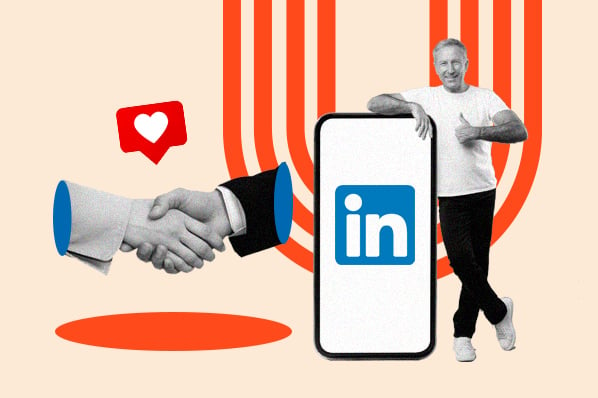LinkedIn provides access to an ocean of prospects and some valuable insight into what makes them tick — but connecting with them is a struggle in itself. Prospecting on the network is every bit as tricky as it is potentially productive, and if you want to do it effectively, you need to master the art of the LinkedIn sales message.
To help you get there, we've put together a blueprint of a LinkedIn prospecting message that can consistently deliver results and tacked on some other effective LinkedIn message templates to boot.
Download 37 Tips for Social Selling on LinkedIn
Effective LinkedIn Messages
Whether you're sending an InMail or a good old-fashioned message, look to the following template as a guide.
Let's dig into the nine components.
1. Their first name
Start with some degree of familiarity and specificity — greet your prospect by their first name so they know this message is intended specifically for them. "To whom it may concern" won't cut it when sending LinkedIn prospecting messages.
2. Your name and company
Make things easier for your prospect — don't make them click on your profile to figure out who's messaging them. That draws attention from what you're trying to say. Introduce yourself right upfront, so they can concentrate on what you've written instead of thinking, "Who is this, anyway?"
3. Commonality
Prospecting messages are awkward by nature — and coming off as totally unfamiliar can kick that awkwardness up a notch. You want to make your message a bit warmer by establishing some kind of commonality.
Data has shown that buyers and consumers react much differently to LinkedIn messages from salespeople with whom they share connections than salespeople with whom they don't.
If you have something in common with the buyer — such as a group or acquaintance — state this shared connection early on. It'll boost your credibility in their eyes and encourage them to drop their guard.
4. Observation
Every LinkedIn prospecting message should have some sort of focal point — something that prompted you to send the message. That typically comes from the prospect, themselves.
Always remember, sales messages, emails, and voicemails should be buyer-centric, not about you — so you need to show them that you value their insight and activity.
Do your research, and show that you have by mentioning their activities and content like social media group contributions, blog posts, or whitepapers.
5. Resource offer
In many cases, you're going to want to contribute something in exchange for the observation you just made. Offer something productive, meaningful, and relevant that can help them do what they do better.
That might include resources like a content asset, an introduction to an expert, or a recommendation for further reading about the subject you're discussing. This demonstrates your ability to help and add value from the get-go.
6. Question
Don't underestimate the power of a thoughtful question to get the conversation flowing. Some questions HubSpot Director of Sales Michael Pici recommends include:
- "Is [topic] a priority for you right now?"
- "Do you have any unanswered questions about [topic]?"
- "How, if at all, would you like to improve your strategy?"
Every conversation needs a starting point — a thoughtful question is a borderline-surefire way to set things in motion.
7. Interest
Again, everything about your messages should be buyer-centric, and demonstrating sincere interest is central to making that happen. Let them know you care about their situation here — the word "curious" never hurts.
8. Request
Every sales interaction needs to have an endgame. You're not starting a conversation with a prospect just to chat a bit and go your separate ways. You need to explicitly define next steps.
What do you hope to get out of this message? A call? An email exchange? A referral? Whatever it is, make sure to ask for it in clear terms. If you've piqued the prospect's interest effectively, you won't have any trouble getting them to follow through.
Bear in mind that "clear next steps" should never come in the form of a sales pitch. Overly "salesy" messages tend to fall flat. You're trying to start a discussion with your message — the hard selling comes further down the line.
Here's the template for the message I've just described:
Best LinkedIn Prospecting Message
Hey [Prospect],
My name is [your name and company]. We're both [commonality], and I saw your [observation] and thought it was really interesting.
It made me think of [resource offer] — I was surprised to learn [information relevant to the resource offer].
[Relevant question]? I'm curious to hear your thoughts. Can we set up [next steps]?
Best,
[Your Name]
Linkedin Prospecting Message Templates
Here are a few other effective templates you can use for your LinkedIn prospecting efforts.
1. "Congratulations!"
Prospects, like anyone else, are proud of their achievements — especially while they're still fresh. That's why recent accomplishments can provide a solid basis for an effective LinkedIn prospecting message.
A new promotion, a successful round of funding, or any other career or company milestone a prospect hits provides an opportunity for connection. In this case, you don't have to pitch anything, you just have to commend them to let them know you appreciate their success and keep yourself top of mind.
"Congratulations!" Template
Hey [Prospect],
Just wanted to reach out and congratulate you for [their recent accomplishment].
I look forward to seeing how you thrive and continue to shake up [their field].
Best,
[Your Name]
2. Complimenting Their Content
Some of your prospects will publish thought-leadership content that can provide excellent starting points for productive conversations. With this message, you can impress them with your knowledge of their space and let them know you value them through your interest in their thoughts.
The keys to this one are specificity and thoughtfulness. You need to actually read the content they wrote and be able to discuss specific points they made. This message template is a conversation starter, but you'll have to be prepared to have some in-depth back and forth once they respond.
Complimenting Their Content Template
Hey [Prospect],
I wanted to let you know that I read your [piece of content] about [subject] and was struck by how thoughtful, incisive, and well-written it was. You're doing a great job establishing yourself as a thought leader in [their space]!
You mentioned [reference to a specific point made in the content]. I was wondering if you had any thoughts about [open-ended, forward-thinking ask relevant to the content].
Best,
[Your Name]

3. Passing Along Content They Might Be Interested In
Like the previous one, this LinkedIn message strategy is geared towards starting thoughtful conversations. If you see them demonstrating interest in a subject — whether that be through something like social activity or content creation — try to capitalize on it.
Send them relevant content — written either by you or someone in their space — that ties into whatever they appear to be interested in. Again, the key here is thoughtfulness. They're not going to read your recommended content if it seems boring or pointless. So be selective with what you send, and always leave the conversation open-ended.
Passing Along Content They Might Be Interested In
Hey [Prospect],
I saw your [piece of content] about [subject] and was struck by how thoughtful and incisive it was. I was actually reading [another piece of content relevant to theirs] and thought you might be interested.
Here's the link: [link]. Would love to hear your thoughts!
Best,
[Your Name]
Crafting LinkedIn prospecting messages that resonate with prospects enough to start and sustain productive conversations is certainly easier said than done — but if you keep things buyer-centric, demonstrate sincere interest, and set yourself up for some solid back-and-forth, you should be in a good place.
Social Selling on LinkedIn

.webp)

![Here’s how to write a professional LinkedIn headline to 10x your presence [+ examples]](https://53.fs1.hubspotusercontent-na1.net/hubfs/53/linkedin%20headline%20featured.webp)
![15 Best LinkedIn Summary & Bio Examples [+ How to Write Your Own]](https://53.fs1.hubspotusercontent-na1.net/hubfs/53/linkedin-summary-examples-4.jpg)



.jpg)

![How to Write InMail Messages to Recruiters on LinkedIn [Samples + Templates]](https://53.fs1.hubspotusercontent-na1.net/hubfs/53/how-to-craft-an-inmail-that-gets-results-1.jpg)

